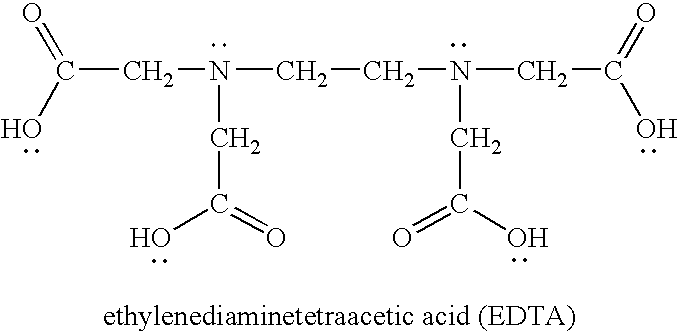Method for reducing odor using metal-modified particles
- Summary
- Abstract
- Description
- Claims
- Application Information
AI Technical Summary
Benefits of technology
Problems solved by technology
Method used
Image
Examples
example 1
[0066] The effectiveness of the modified particles to adsorb odorous compounds was demonstrated. The particles were Snowtex-AK, which are colloidal silica nanoparticles coated with alumina and commercially available from Nissan Chemical America of Houston, Tex. The particles have an average particle size of between 10 to 20 nanometers and a surface area between 180 to 240 square meters per gram.
[0067] The particles were modified with a transition metal as follows. Initially, 1 milliliter of a 10-millimolar anthraquinone dye solution (carminic acid, Acid Blue 45, Alizarin Red S, and Acid Green 41 all separately tested) was added to an equal volume of a 10-millimolar of copper chloride (CuCl2). The carminic acid-containing solution, for instance, immediately changed from a medium red color to a deep reddish purple color, indicating the formation of a complex. To this complex was then added 1 millimeter of a 200-micromolar solution of the Snowtex-AK particles (approximately 20 wt. % s...
example 2
[0069] The effectiveness of the modified particles to adsorb odorous compounds was demonstrated. The particles were Snowtex-AK, which are colloidal silica nanoparticles coated with alumina and commercially available from Nissan Chemical America of Houston, Tex. The particles were modified with a transition metal as follows. Initially, 1 milliliter of a 10-millimolar hematoxylin dye solution was added to an equal volume of a 10-millimolar of copper chloride (CuCl2). The solution immediately changed from a pale yellow to a deep blue, indicating the formation of a complex. To this complex was then added 1 millimeter of a 200-micromolar solution of the Snowtex-AK particles (approximately 20 wt. % solids). Thus, the ratio of copper-coordinated dye to the particles was 50:1. The solution rapidly changed in color as the second catechol group bonded to the alumina-coated particles.
[0070] The mixture was stirred at room temperature for 20 minutes, and then the solvent was removed under rota...
example 3
[0072] Modified particles were formed as in Example 2, except that the ratio of copper-coodinated dye to the particles was 100:1. 10 milliliters of this solution was then placed into a 3500 MW cutoff dialysis bag and dialyzed overnight against 2 liters of distilled deionized water. Upon completion, there was only a small amount of dye that had diffused out of the dialysis bag, indicating almost complete chemisorption of the copper-dye complex onto the particles. The water was removed from this solution under rotary evaporation. The solution containing the dye were applied to a polyester / cotton blend (from a t-shirt). The polyester / cotton blend was subjected to 3 washes in hot water / detergent using a commercial washing machine. The intense coloration of the fabric from the dye complex was only marginally reduced by this process, indicating high durability of the coating.
PUM
| Property | Measurement | Unit |
|---|---|---|
| Fraction | aaaaa | aaaaa |
| Fraction | aaaaa | aaaaa |
| Size | aaaaa | aaaaa |
Abstract
Description
Claims
Application Information
 Login to View More
Login to View More - R&D
- Intellectual Property
- Life Sciences
- Materials
- Tech Scout
- Unparalleled Data Quality
- Higher Quality Content
- 60% Fewer Hallucinations
Browse by: Latest US Patents, China's latest patents, Technical Efficacy Thesaurus, Application Domain, Technology Topic, Popular Technical Reports.
© 2025 PatSnap. All rights reserved.Legal|Privacy policy|Modern Slavery Act Transparency Statement|Sitemap|About US| Contact US: help@patsnap.com



